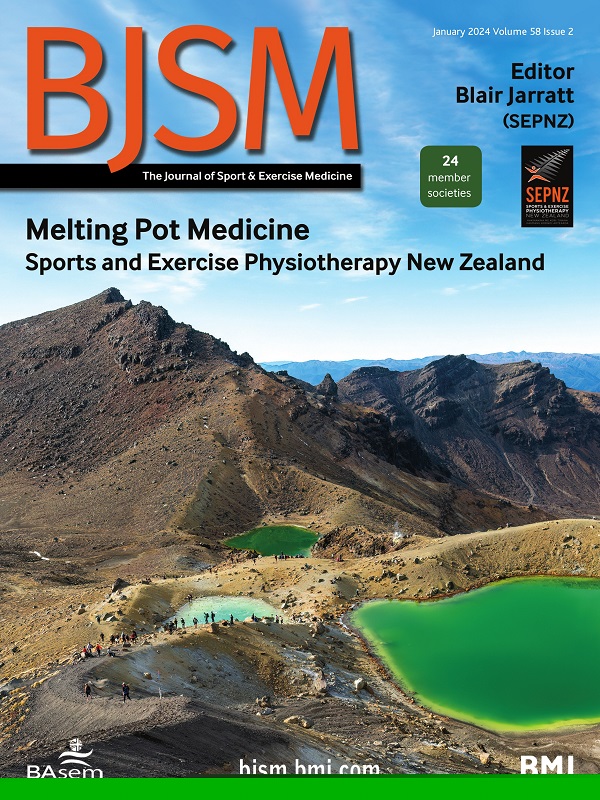男性青训足球运动员骺端损伤随年龄的远端到近端进展:一项为期两个赛季的前瞻性队列研究,共16024个球员赛季
IF 16.2
1区 医学
Q1 SPORT SCIENCES
引用次数: 0
摘要
青少年足球运动员容易受到骨骺损伤,这可能对健康和表现产生长期影响。目的是评估两个赛季U9-U21青少年足球运动员肩关节损伤的发生率、严重程度和负担。方法对英超和甲级足球学院(U9-U21)男子青训球员进行时间损失损伤和比赛/训练暴露的跟踪调查。采用Orchard运动损伤分类系统(OSICS)对16024个运动员赛季的脊柱损伤进行分类,并对其发生率、严重程度和负担进行分析。结果共报告损伤10 589例,其中骺端损伤603例。这些损伤随着年龄的增长从远端到近端进展,最常见于年轻球员(U9、U10和U11)的脚踝/足部,其次是膝盖(U12)和老年球员(U15、U16和U18)的髋关节/腹股沟。在所有球员阶段(U9-U21),与脚踝/足部(2.2)和骨盆/骶骨(1.4)相比,髋关节/腹股沟(3.5)和膝关节(3.4)的受伤负担(天/1000小时)更高,U12-U16组的肩胛骨发生率(~0.4伤/1000小时)和负担(~20天/1000小时)最高,与受伤位置无关。随着年龄的增长,损伤严重程度(中位天数)有明显的增加趋势:U9-U11 (20), U12-U14 (29), U15-U16(38)和U18-U21(35)。结论随着年龄的增长,棘突损伤表现为从远端到近端进展,在髋关节/腹股沟和膝关节以及U12-U16组中观察到的损伤负担最重。这些发现可以帮助青少年足球学院采取伤害缓解策略。无数据。由于道德协议条款的原因,我们无法提供个人数据。本文章由计算机程序翻译,如有差异,请以英文原文为准。
Distal-to-proximal progression of apophyseal injuries with age in male youth academy footballers: a two-season prospective cohort study of 16,024 player-seasons
Objectives Youth football players are vulnerable to apophyseal injuries, which can have long-term consequences for health and performance. The objective was to assess the incidence, severity and burden of apophyseal injuries among U9–U21 academy football players over two seasons. Methods Time-loss injuries and match/training exposure were tracked in male academy football players (U9–U21) from Premier League and Category One Academies. Apophyseal injuries were identified in a cohort of 16 024 player-seasons using Orchard Sports Injury Classification System (OSICS) codes, and their incidence, severity and burden were analysed. Results A total of 10 589 injuries were reported, including 603 apophyseal injuries. These injuries followed a distal-to-proximal progression with age, occurring most frequently in the ankle/foot in younger players (U9, U10 and U11), followed by the knee (U12) and hip/groin in older players (U15, U16 and U18). Across all player phases (U9–U21), injury burden (days/1000 hours) was higher in the hip/groin (3.5) and knee (3.4), compared with the ankle/foot (2.2) and pelvis/sacrum (1.4), with the highest apophyseal incidence (~0.4 injuries/1000 hours) and burden (~20 days/1000 hours) observed in the U12–U16 group, regardless of injury location. A significant trend of increasing injury severity (median days) was observed with age: U9–U11 (20), U12–U14 (29), U15–U16 (38) and U18–U21 (35). Conclusions Apophyseal injuries exhibit a distal-to-proximal progression with age, with the highest injury burden observed at the hip/groin and knee regions and in the U12–U16 group. These findings can help inform injury mitigation strategies adopted in youth academy football. No data are available. Individual data are not available upon request due to the ethics agreement terms.
求助全文
通过发布文献求助,成功后即可免费获取论文全文。
去求助
来源期刊
CiteScore
27.10
自引率
4.90%
发文量
217
审稿时长
3-8 weeks
期刊介绍:
The British Journal of Sports Medicine (BJSM) is a dynamic platform that presents groundbreaking research, thought-provoking reviews, and meaningful discussions on sport and exercise medicine. Our focus encompasses various clinically-relevant aspects such as physiotherapy, physical therapy, and rehabilitation. With an aim to foster innovation, education, and knowledge translation, we strive to bridge the gap between research and practical implementation in the field. Our multi-media approach, including web, print, video, and audio resources, along with our active presence on social media, connects a global community of healthcare professionals dedicated to treating active individuals.

 求助内容:
求助内容: 应助结果提醒方式:
应助结果提醒方式:


